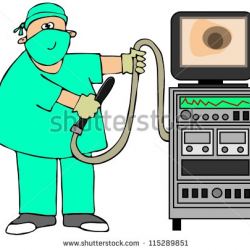
If you are over the age of 50, your doctor has most likely advised you to get a colonoscopy- the gold standard procedure for early detection and removal of growths called polyps, that can potentially turn into deadly colorectal cancer (CRC). But despite its proven effectiveness, the idea of getting a colonoscopy invokes dread and apprehension in many people. Understandably, no one looks forward at the thought of drinking a gallon of gag-inducing bowel-prep and spending hours running to the bathroom, which is prelude to having a tube inserted through the rectum and snaked through the intestinal tract, while a camera looks for suspicious growths. But it is actually not as terrible as it sounds. In fact, the preparation is more unpleasant than the actual procedure which is done once every ten years, under anesthesia.
Why get screened for colon cancer?
Colorectal cancer (cancer of the colon or rectum) is the second leading cause of cancer-related deaths in the United States and the third most common cancer in men and women. According to a CDC report, in 2013 alone, 136,119 people in the United States were diagnosed with colorectal cancer, 51, 813 of whom died from it. In another study of individuals who had a colonoscopy, precancerous growths called adenomas were found in 25% of men and 15% of women. The timely removal of these adenomas has led to a decline in colon cancer rate in the U.S. over the years.
Colonoscopy is not only good at detecting large cancers but also small precancerous polyps that can get missed by other techniques. It is 75-95% sensitive in detecting precancerous growths that are 6 mm or larger. Another advantage of colonoscopy is the ability of doctors to remove suspicious growths at the same time. But like any procedure, it is not without risk. Bleeding, perforation (puncture), infection, or anesthesia related reaction are a rare possibility. According to a study published in Ann Intern Med 2006, the incidence of perforation (tear) was 0.6 per 1000 (without biopsy) and 1.1 per 1000 (with biopsy), while the incidence of overall serious complications was 0.8 per 1000 and 7.0 per 1000, respectively.
If you are averse to the idea of getting a colonoscopy, there are other options you can consider- albeit with some caveats:
- Fecal Occult Blood Test (FOBT): This annual test involves checking a stool sample for traces of blood, which often happens when there is a cancerous growth in the intestine. In one study, its sensitivity for detecting cancer was 79.4%. The down side is that small precancerous polyps do not bleed and will likely be missed. Furthermore, certain foods and medicine can give false positive results requiring unnecessary colonoscopy to follow.
- FIT (fecal immunochemical test): This annual stool test is replacing the FOBT. It is better at detecting human blood in the stool, and the result is not confounded by food or medication. It only requires a single stool sample and has no food or diet restrictions, making it a preferred alternative to its predecessor. It is approximately 80% sensitive in detecting cancer (which is comparable to colonoscopy) but only about 20-30% sensitive in detecting pre-cancerous growths--a weakness of stool-based tests.
- Stool DNA Test: This test detects abnormal DNA leaked from cancer cells, into the stool. There is a test that combines the stool DNA test with the FIT test called Cologuard with better detection rate. It is 92.3% sensitive at detecting cancerous growth and 42.4% sensitive at detecting adenoma (better than the FIT test alone). Stool DNA test detects more cancers than the other stool tests and requires less frequent testing (every three years), but the downside is a higher false positive rate and higher cost.
- CT colonography (virtual colonoscopy): This test involves 3D imaging of the entire colon by a CT scanner, to look for abnormal growths, every five years. According to a meta-analysis, it has 73-98% sensitivity in detecting precancerous growths (adenomas) - comparable to colonoscopy and with 96-98% accuracy. Biopsy for false positive growths is lower than with colonoscopy. One study showed that “CTC every five years yielded similar life-years gained as colonoscopy every ten years, sigmoidoscopy every ten years [plus annual FIT], and annual FIT alone”.
- Flexible Sigmoidoscopy (FS): This test is very similar to a colonoscopy with a few differences: it is done with a shorter tube (sigmoidoscope), which only reaches up to the last 60 cm of the large intestine. Any abnormalities in the remaining parts of the intestine go unchecked. But when a sigmoidoscopy (every five years) is combined with annual stool testing, it becomes comparable to colonoscopy. Sigmoidoscopy can be done at a doctor’s office without the need for sedation. While small polyps can removed by FS, larger ones will require a colonoscopy.
No screening test, including colonoscopy, is full-proof. There are advantages and disadvantages to each. But the reality is that colorectal cancer is a serious problem, which can be prevented by screening. The unpleasantries of getting a screening are far less terrifying than the alternative - advanced colorectal cancer that could have been prevented. While colonoscopy offers a single-step process to find and remove polyps, it is associated with some risks that should be weighed against its benefit. For those who don’t mind more frequent testing, there are alternative screening methods with comparable efficacy and simplicity when done properly. But remember, a colonoscopy will still be necessary if the result is abnormal.
